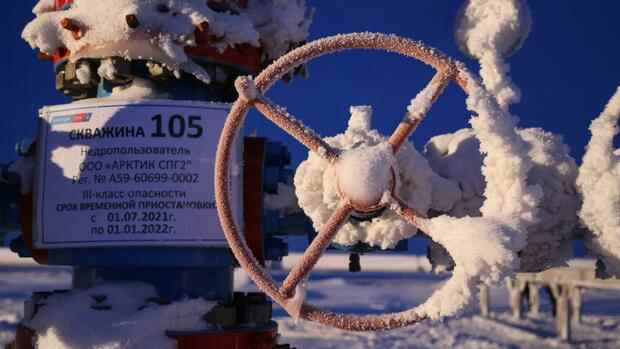Athens, Rome, Vienna, Paris, Madrid, Stockholm Fear of Russian troops invading Ukraine and the ensuing economic dispute with Moscow have led to gas supply crisis meetings in some European capitals. Greek Prime Minister Kyriakos Mitsotakis discussed emergency scenarios with a team in Athens on Monday. Among those present were Energy Minister Kostas Skrekas and the heads of the state gas supplier Depa, the regulatory authority RAE and the electricity supplier Public Power Corporation.
Greece obtains 40 to 45 percent of its gas from the Russian state-owned company Gazprom. The rest comes via Turkey from Azerbaijan and as liquefied natural gas (LNG) from Algeria, Qatar and the USA. Depa only signed a new supply contract with Gazprom for the years 2022 to 2026 at the beginning of January. Now it remains to be seen what the signatures are worth.
Natural gas is key for heat, but also for electricity production in gas-fired power plants. The good news for Greece: A disruption in the pipelines carrying Russian natural gas to Europe via Ukraine would hardly affect the country because Gazprom supplies it through pipelines that run through Turkey and Bulgaria. Should they also fail, experts estimate that Greece could compensate for around half of the losses with additional deliveries from Azerbaijan and more LNG imports.
The reservoirs of the liquid gas terminal Revithoussa near Athens are fuller than they have been for a long time. Nine LNG tankers arrived there in January, and a further seven deliveries are expected by the end of February. However, it is unclear how much LNG can be obtained on the world market in the event of a crisis – and at what price.
Top jobs of the day
Find the best jobs now and
be notified by email.
In the event of a complete cessation of Russian gas supplies, the government wants to operate gas-fired power plants with heating oil. In addition, the state electricity supplier DEI is making preparations to restart lignite-fired power plants that have already been taken off the grid in an emergency.
Rome is also talking to Qatar about LPG
The Italian government is looking for alternatives to Russian gas: Prime Minister Mario Draghi and Foreign Minister Luigi Di Maio met with the Qatari Deputy Prime Minister on Monday. Qatar is one of the largest LNG exporters in the world. Italy already gets almost ten percent of its gas from the country. Now Rome hopes that this amount can be increased in the event of war.
Italy is one of the countries that, at 40 percent, obtain a large proportion of their natural gas from Russia. In January, when Russia reduced its deliveries to Europe, Italy was able to compensate for this by buying more liquid gas from other countries and by stockpiling it.
But the memories are at a critical level. After all, the time is playing for Italy: the winter is already over in large parts of the country, people have to heat less. In the long term, Rome wants to become less dependent on gas, which makes up more than 42 percent of the energy mix, by expanding renewable energies.
In Austria, which gets up to 80 percent of its consumption from Russia, Economics Minister Margarete Schramböck spoke out in favor of “creating strategic gas reserves”. In addition, the country needs new energy partnerships in addition to the long-term gas supply contracts with Russia and Norway. According to the minister, she has held talks with representatives of the United Arab Emirates and Oman. Exploratory talks are also planned with Saudi Arabia.
Construction and increased use of LNG terminals
The Czech Republic, on the other hand, wants to participate in an LNG terminal. This is laid down in an agreement reached by the parties‧alliance that has been in power since last autumn. Participation in the Polish terminal in Swinoujscie seems most likely. In order to route gas from Poland to the Czech Republic, however, the pipeline connection between the two countries still has to be improved.
More on the events surrounding Russia
Finland and the Baltic countries of Estonia, Latvia and Lithuania feel confirmed in their strategy of making themselves less dependent on Russian natural gas at an early stage. An LNG terminal was built years ago in Klaipeda, Lithuania, for which Norway is the main supplier. LPG is also delivered from Klaipeda to neighboring countries, so that the dependency on Russian gas supplies has decreased significantly. Estonia is also planning to build two LNG terminals.
Spain also sees itself well diversified. Gas imported from Russia accounts for only around ten percent of gas imports and does not come via pipelines, but in liquefied form by ship. Spain has seven ports with facilities capable of regasifying LNG.
This corresponds to 30 percent of European capacities. However, they are of little help to the rest of Europe at the moment, because there are no gas pipelines from Spain to northern Europe. “Only then does transport from Spain make sense,” says Diego Rodríguez Rodríguez, an energy expert at the Complutense University in Madrid.
France is also significantly less dependent on Russian gas than other European countries. The French energy company Engie sees the supply secured in the crisis. There is a broad portfolio in the countries of origin, it says. The gas tanks are still full.
France has four LNG terminals, which the country relies on in the event of a shortage. In addition, 70 percent of France’s electricity generation comes from nuclear power. And many French also heat with electricity.
More: Interview with Ursula von der Leyen: “Make the Russian economy even more fragile” – EU wants to stop Moscow with capital freezes and tech embargo
